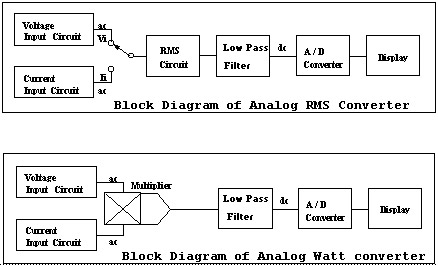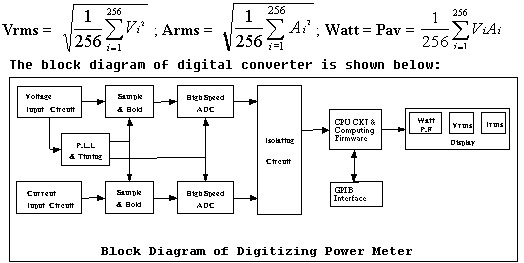

Application Notes-400
The Basic of Power Meter
The AC Line Power Meter is used to measure the power consumption of a equipment which is drawn from 115/230V 50/60Hz power line. For the energy or environment control purpose, a precise Current, Watt, Power Factor measurements are the first step, this Application Note is a Guide to describe the theory of power meter and to choose the most suitable Power Meter from the market today.
1 Theory of Power Meter
From the theory, the definition of measurement item of power meter is described below:
1.1 Vrms, Arms (Root Mean Square)

1.2 Average Power (Watt)

1.3 Power Factor

The above equation is true for any voltage and current waveform, the traditional PF=COS˘GK is validity for sinusoidal waveform only, it just a special case on both voltage and current waveform are a sinusoidal waveform.
2 Implement method of Power Meter
2.1 Analog converter with Digital read out
Using Analog
square root, multiply, and integration circuit according the above equation,
then get a dc voltage which is proportional to Vrms,
Arms, and Watt, finally, uses a low speed 3 1/2 or 4 1/2 A/D converter to
get digital display.
The Block diagram of Analog RMS and Watt converter are shown below:

2.2 Digital converter with Digital read out
Using A/D
converter to sampling each Vi and Ai within a
cycle simultaneously, then uses a CPU and software calculation (according
equation below) to get Vrms, Arms, and Watt
result on display. The more
samples and resolution would get more accuracy, 4010/4011 uses 256 samples
and 12 bit A/D converter to get better than 0.1% accuracy.
Using A/D converter to sampling each Vi and Ai within a cycle simultaneously, then uses a CPU and software calculation (according equation below) to get Vrms, Arms, and Watt
result on display. The more samples and resolution would get more accuracy, 4010/4011 uses 256 samples and 12 bit A/D converter to get better than 0.1% accuracy.

3.1 Specifications
3.1.1
Accuracy
The
accuracy should be as low as possible, Normally, the accuracy includes two
portion which is reading and range, where latter is a constant error,
therefore, you have to make sure the Power Meter's resolution and accuracy
is enough for your measuring. Digital converter definitely has much better
accuracy than Analog converter, this is because only A/D conversion error in
digital converter, which is much less than analog converter's
RMS ,Watt,PF
conversion, A/D conversion error.
The accuracy should be as low as possible, Normally, the accuracy includes two portion which is reading and range, where latter is a constant error, therefore, you have to make sure the Power Meter's resolution and accuracy is enough for your measuring. Digital converter definitely has much better accuracy than Analog converter, this is because only A/D conversion error in digital converter, which is much less than analog converter's RMS ,Watt,PF conversion, A/D conversion error.
3.1.2 Current Crest
Factor
Generally, load current is a distorted pulse waveform, therefore, a proper
range should be select, and load peak current should be kept within the
allowable peak range. It would be the best if the Power Meter can move to
higher measuring range to avoid peak-over error when voltage/current signal
is over the peak limit of the range. Digital converter can implement
peak-error free with software; however, analog converter can not have this
feature for a distorted waveform.
3.1.2 Current Crest Factor
Generally, load current is a distorted pulse waveform, therefore, a proper range should be select, and load peak current should be kept within the allowable peak range. It would be the best if the Power Meter can move to higher measuring range to avoid peak-over error when voltage/current signal is over the peak limit of the range. Digital converter can implement peak-error free with software; however, analog converter can not have this feature for a distorted waveform.
3.1.3 Calibration Cycle
A reliable measuring instrument should be calibrated periodically, the Power
Meter's calibration cycle is varied for different implement method. For the
factor of component rating, aging, and drift, an analog converter power
meter has about 3 months, a digital converter power meter has 1 year.
3.1.3 Calibration Cycle
A reliable measuring instrument should be calibrated periodically, the Power Meter's calibration cycle is varied for different implement method. For the factor of component rating, aging, and drift, an analog converter power meter has about 3 months, a digital converter power meter has 1 year.
3.1.4 Effective measuring range
The effective measuring range should be as large as possible. Generally, a
power meter with Analog converter has 10% to 100% effective measuring range,
the measuring errors are increase rapidly if the input signal is lower than
the 10% of its range; meanwhile, a power meter with digital converter has 1%
to 100% effective measuring range, it has more reliable result when load
current is very small, this feature is important especially for the GREEN
product.
3.2 Ask for demo and make a verification
This is the most practical way to verify if the power meter is suitable for
your product, the following verification method is practical and useful:
3.1.4 Effective measuring range
The effective measuring range should be as large as possible. Generally, a power meter with Analog converter has 10% to 100% effective measuring range, the measuring errors are increase rapidly if the input signal is lower than the 10% of its range; meanwhile, a power meter with digital converter has 1% to 100% effective measuring range, it has more reliable result when load current is very small, this feature is important especially for the GREEN product.
3.2 Ask for demo and make a verification
This is the most practical way to verify if the power meter is suitable for your product, the following verification method is practical and useful:
3.2.1 Voltage/Current range
Set input Voltage/Current signal to 50% of its lowest range, then switch to
all other Voltage/Current range, for a good power meter the reading should
be consistence.
3.2.1 Voltage/Current range
Set input Voltage/Current signal to 50% of its lowest range, then switch to all other Voltage/Current range, for a good power meter the reading should be consistence.
3.2.2 Power(Watt) range
Measuring the Watt reading on 115V and 230V line input( this is possible if
your product will be shipped to other country, of course, you have to change
line voltage and line voltage switch on your product for this testing).
Generally, the Watt reading should be very close, actually the Watts reading
on 230V is a little bit lower than 115V for the power loss on 230V line
voltage is smaller.
4 Conclusion
Prodigit Model 4010/4011 Digitizing Power Meter is using digital converter,
it has 0.1% accuracy, Auto range up capability for all voltage and current
ranges to prevent distorted measurement, down to 1% effective measuring
range, GPIB standard interface, and reliable 1 year calibration cycle. The
4010/4011 has been proved to have excellent consistence measuring result
from different power meter unit, and/or an equipment (UUT) power on 115V or
230V line voltage.
3.2.2 Power(Watt) range
Measuring the Watt reading on 115V and 230V line input( this is possible if your product will be shipped to other country, of course, you have to change line voltage and line voltage switch on your product for this testing). Generally, the Watt reading should be very close, actually the Watts reading on 230V is a little bit lower than 115V for the power loss on 230V line voltage is smaller.
4 Conclusion
Prodigit Model 4010/4011 Digitizing Power Meter is using digital converter, it has 0.1% accuracy, Auto range up capability for all voltage and current ranges to prevent distorted measurement, down to 1% effective measuring range, GPIB standard interface, and reliable 1 year calibration cycle. The 4010/4011 has been proved to have excellent consistence measuring result from different power meter unit, and/or an equipment (UUT) power on 115V or 230V line voltage.